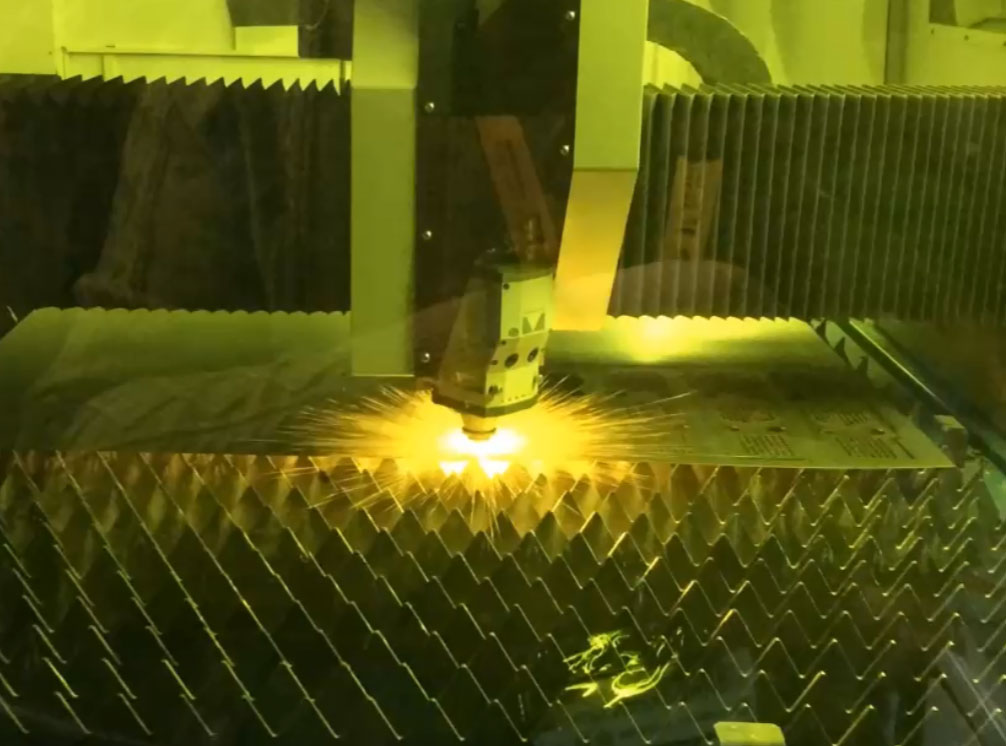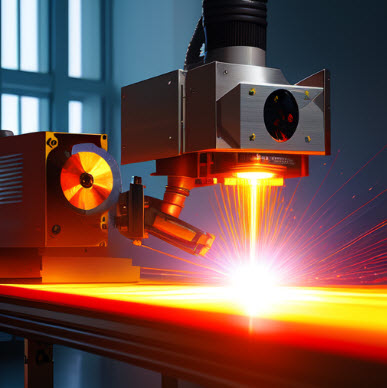Laser News
266nm UV High Peak Power Laser

Ultraviolet laser is widely used in fluorescence detection, fine processing and lithography due to its high single photon energy and small diffraction effect. At present, in the field of industrial and scientific research, the method of obtaining ultraviolet laser is mainly divided into gas ultraviolet Lasers and solid-state lasers. Gas ultraviolet lasers include excimer lasers, hydrogen ion lasers, and nitrogen molecular lasers. However, gas lasers have been replaced by solid-state ultraviolet lasers pumped by laser diodes (LD) because of their large size, short life, and long-term maintenance. The most straightforward method for obtaining an all-solid-state UV laser is to perform intracavity or extracavity frequency conversion on the near-infrared wave of an erbium-doped solid-state laser to generate three or fourth harmonics. High-power end-pump UV lasers use Nd:YVO4 as a laser crystal, which is characterized by higher repetition frequency but lower peak power. In order to obtain higher peak power, this paper reports an LD end-pumped Nd:YAG acousto-optic Q-switched high peak power UV 266 nm laser.
1. Experimental Device
The experimental setup is shown in Figure 1. LD is LIMO’s maximum output power of 30W, center wavelength is 808.7nm, spectral width is 2nm, horizontal polarization, polarization ratio is 30:1, fiber-coupled output, fiber core diameter 400 μm, numerical aperture NA 0 .22 ; Image coupling system with 1:1.5; Nd :YAG size 3 mm × 3 mm ×7 mm, doping concentration 0.7 %, left 808nm high permeability and 1064 nm high reflective film, right end plating 1064nm Antireflection coating, wrapped in indium foil into copper heat sink; sound and light Q switch produced by NEOS, ultrasonic frequency 40MHz, shutdown power 10W; M 1 is infrared output mirror, left side plated 1064nm partially transmissive film (transmission Rate T = 30%), the right end is plated with a 1064 nm antireflection coating.
Commonly used 1064 nm doubling crystals are KTP, LBO, BBO, etc. KTP crystals have excellent performance, high efficiency and small deviation, so they are widely used in the second harmonic generation experiment of 1064 nm, and have achieved good laboratory indicators. However, K TP produces a so-called “grey trace” phenomenon at high power, especially when the power of the laser is relatively high. Once the crystal is formed, the stability and efficiency of the laser will be seriously affected. KTP is rarely used as a nonlinear crystal in high power lasers. Although the BBO crystal has a high effective nonlinear coefficient, the off-angle is large, which seriously affects the beam quality, and the BBO deliquescent is serious, and it is rarely used in practice. In summary, we use LBO crystals as double frequency crystals. Although the effective nonlinear coefficient of the LBO crystal is small, the LBO has a small separation angle and a large allowable angle, and a long crystal can be used to improve the efficiency. LBO double-sided 1064 nm and 532 nm two-color AR coating with a cutting angle of θ=90°, placed in a copper heat sink, and precisely temperature controlled by TEC (thermoelectric cooler).
Currently, quadruple-frequency crystals are available in fewer applications, including BBO and CLBO. Although CLBO has better performance, but the deliquescent is serious, and it is currently unable to provide its products in China, BBO crystal is an excellent quadruple frequency crystal, its effective nonlinear coefficient is large, and the market can buy very mature products. In the experiment, we used BBO crystal as the quadruple frequency crystal, and BBO crystal was coated on both sides with 1064, 532 and 266 nm antireflection coatings, and the cutting angle θ=44.7°.
Since Nd :YAG can achieve very high peak power after Q-switching, no additional focusing system is used, which makes the whole system very compact and eliminates the dispersion effect of focusing. Experiments have shown that even without focusing system, it can be very high. Light-to-light conversion rate. Taking the cavity length to 70 mm, the relationship between the laser spot on the Nd:YAG crystal and the focal length of the thermal lens is calculated, as shown in Fig. 2. Using a stable cavity method, the thermal lens focal length of Nd :YAG is 150 mm at a pump power of 25 W. It can be seen from Fig. 2 that the cavity is in a stable range, the laser spot radius on the crystal is about 230 μm, and the ratio of the pump spot radius is 0.77, which satisfies the mode matching requirement under high power pumping.
2 Experimental results and analysis
The experimental results show that the relationship between the output power of 1 064 nm and the injected power is shown in Fig. 3. When the pump power is 25 W, the maximum output power is 8.1 W for continuous output; when the modulation frequency is 10 kHz and the Brewster plate (BP) is not inserted in the cavity, the maximum output power is 6.2 W; The output power after BP is 5.2 W. Investigate the polarization ratio of the 1 064 nm infrared laser: when the pump source is 40:1 LD, the output polarization ratio of the 1 064 nm laser is 38:1; when the pump source is 5:1 LD, the output is 1 064. The nm laser polarization ratio is 5:1. It can be seen that the polarization ratio of the output laser is substantially the same as the polarization ratio of the pump source and the polarization direction is the same, which is very important for the nonlinear frequency conversion process. When a LD with a polarization ratio of 5:1 is used as the pump source, the polarization ratio of the output laser after adding BP to the cavity is about 100:1.
High-polarization ratio LD pumping, low polarization ratio LD pumping, low polarization ratio LD pumping chamber plus BP chip for extracavity frequency doubling experiment, the green light output power obtained at the modulation frequency of 10 kHz The relationship between pump power is shown in Figure 4. At the same pump power, the LD of the high polarization ratio is nearly 25% higher than the green power of the LD output of the low polarization ratio. In the case of LD pump with low polarization ratio, the doubling efficiency of the inserted BP chip is also large. Improved; when using a high polarization ratio LD pump power of 25 W and a modulation frequency of 10 kHz, the highest green light output power is 2.2 W, the pulse width is 7 ns, and the peak power is 31.4 kW. Further four-frequency experiments, the relationship between the power output of the three structures and the pump power is shown in Figure 5. When the modulation frequency is 10 kHz, the LD array with a polarization ratio of 40:1 is used as the pump source, and the highest output ultraviolet 266 nm laser power is 0.25 W. The low polarization ratio LD array is used as the pump source to join the BP sheet and The UV power output when the BP piece is not added is 0.71 and 0.62 W, respectively.
Figure 6 shows the spot photo and pulse waveform when the UV laser output power is 0.85 W. It can be seen that the 266 nm spot is oval, which is caused by the BBO’s separation effect. The laser has a pulse width of 5 ns and a peak power of up to 17 kW. Figure 7 shows the relationship between the output power and the repetition frequency obtained for three different configurations with a pump power of 25 W. When pumped with a high polarization LD and a modulation frequency of 8 kHz, the output UV power is 0.7 W with a peak of 17.5 kW.
3 Conclusion
Using a compact flat-cavity structure, experiments were performed using a high-polarization ratio LD array (40:1), a low-polarization ratio LD array (5:1), and a low-polarization LD array cavity, respectively, to obtain 266 nm output. The power is 0.85, 0.61, 0.72 W. Among them, the high polarization ratio LD array has the highest output power, single pulse energy 85 μJ, pulse width 5 ns, peak power up to 17.5 kW, pump light to ultraviolet light-to-light conversion rate of 3.4%. Experiments show that the polarization of LD has a great influence on the polarization ratio of fundamental light. For example, when a high polarization ratio LD array is used as the pump source and no polarizing elements are added to the cavity, the polarization of the fundamental light will be very high. High, and the polarization direction of the laser is the same as the polarization direction of the LD. Similar results have been obtained in the literature. The phenomenon that this isotropic N d : YAG is polarized under the pumping of polarized light is not well explained. It is considered that this is related to the thermally induced birefringence effect of Nd :YAG and the diffraction of acousto-optic Q switch. Related to the role, this phenomenon needs further discussion.









